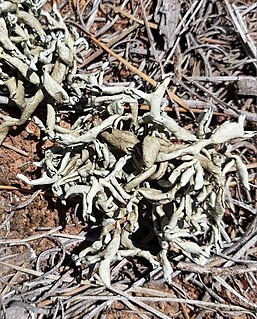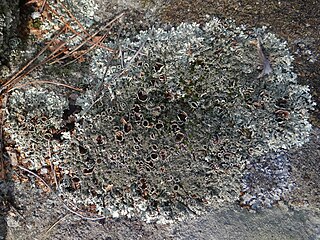
The Parmeliaceae is a large and diverse family of Lecanoromycetes. With over 2700 species in 71 genera, it is the largest family of lichen-forming fungi. The most speciose genera in the family are the well-known groups: Xanthoparmelia, Usnea, Parmotrema, and Hypotrachyna.

Arctoparmelia is a genus of ring lichens in the family Parmeliaceae. The genus was circumscribed by American lichenologist Mason Hale in 1986 with A. centrifuga as the type species. Hale included five species in his original conception of the genus; the Siberian species A. collatolica was added in 2019.

Xanthoparmelia is a genus of foliose lichen in the family Parmeliaceae. Xanthoparmelia is synonymous with Almbornia, Neofuscelia, Chondropsis, Namakwa, Paraparmelia, and Xanthomaculina. This genus of lichen is commonly found in the United States, as well as Australia, New Zealand and Ecuador.
Psiloparmelia is a genus of lichen belonging to the family Parmeliaceae. It contains 13 Southern Hemisphere species, most of which are found growing on rocks at high elevations in South America. There are several characteristic features of the genus that are used to distinguish it from the morphologically similar genera, such as Arctoparmelia, Flavoparmelia, and Xanthoparmelia. These include a dark, velvety lower thallus surface that usually lacks rhizines, a negative test for lichenan, and a high concentration of usnic acid and atranorin in the cortex.
Xanthoparmelia pokornyi is a lichen species in the family Parmeliaceae. It contains the depsides gyrophoric acid and stenosporic acid.

Xanthoparmelia mougeotii is a species of foliose lichen belonging to the family Parmeliaceae.

Xanthoparmelia tinctina is a species of lichen from the family Parmeliaceae that can be found in Arizona, California, Northern Africa and Europe. The upper surface is yellow–green, while the bottom surface is brown and flat, measuring 0.2–0.6 millimetres (0.0079–0.0236 in) in diameter. The apothecia are 2–10 millimetres (0.08–0.39 in) wide, the thallus is laminal and is 3–10 centimetres (1–4 in) in diameter. The disc is either cinnamon-brown or dark brown and is ellipsoided. The pycnidia are immersed, and the conidia are bifusiform, with 8-spored asci that are hyaline and ellipsoid.

Xanthoparmelia convoluta is a vagrant lichen in the family Parmeliaceae found in Australia. It lacks rhizenes that hold it to a substrate, so lives its life moving about in the wind.

Xanthoparmelia conspersa, commonly known as the peppered rock-shield, is a foliose lichen and the type species of genus Xanthoparmelia. It is widely distributed in temperate zones, and has been recorded from Japan, Europe, Africa, North America, and South America.

Xanthoparmelia mexicana, commonly known as the salted rock-shield, is a foliose lichen in the family Parmeliaceae. It grows in 4–10 cm diameter rosettes of gray-green to yellow-green lobes in arid climates all over the world.

Xanthoparmelia scabrosa, jocularly known as sexy footpath lichen or sexy pavement lichen, is a foliose lichen in the family Parmeliaceae. It tolerates a very wide range of substrata, predominantly rock but also tree bark, roofing tiles, glass, and in wetter areas bitumen paths and roads.
Arctoparmelia separata, commonly known as the rippled ring lichen, is a species of foliose, ring lichen in the family Parmeliaceae with a roughly circumpolar distribution.

Xanthoparmelia lineola, commonly known as the tight rock-shield, is a foliose lichen species in the genus Xanthoparmelia. It is a common species with a temperate distribution. Found in North America and South Africa, it grows on rocks.
Rex Bertram Filson is an Australian lichenologist who made major contributions to knowledge of lichens in Australia and Antarctica.
Xanthoparmelia serusiauxii is a species of foliose lichen in the family Parmeliaceae. Found in Namibia, it was formally described as a new species in 1986 by American lichenologist Mason Hale. The type specimen was collected by Hale from the Laguneberg Mountains, southeast of Cape Cross. There, it is common on dolerite boulders and small, flat pebbles. The specific epithet honours Emmanuël Sérusiaux, who, according to Hale, "was the first lichenologist to collect this unusual lichen in Namibia".

Constipatic acid is a fatty acid found in several lichen species. It was isolated, identified, and named by Douglas Chester and John Alan Elix in a 1979 publication. The compound was extracted from the Australian leafy lichen called Xanthoparmelia constipata, which was collected on schist boulders west of Springton, South Australia. The related compounds protoconstipatic acid and dehydroconstipatic acid were also reported concurrently. Syo Kurokawa and Rex Filson had previously detected the compounds using thin-layer chromatography when they formally described the lichen as a new species in 1975, but had not characterised them chemically.

Xanthoparmelia loxodes is a species of foliose lichen in the family Parmeliaceae. It was first formally described by Finnish botanist William Nylander in 1872, as Parmelia loxodes. In 1978, Ted Esslinger created the genus Neofuscelia, which contained species previously classified in Parmelia subgenus Neofusca; Neofuscelia loxodes was one of many species transferred here. In a 2004 molecular phylogenetic study published by Oscar Blanco, Ana Crespo, John A. Elix, David L. Hawksworth and H. Thorsten Lumbsch, they showed that Neofuscelia did not form a clade distinct from Xanthoparmelia, and they reduced it to synonymy under Xanthoparmelia.
Xanthoparmelia kalbii is a species of foliose lichen in the family Parmeliaceae. Found in Brazil, it was described as a species new to science in 1984 by American lichenologist Mason E. Hale. The type was collected in Catimbau National Park in Pernambuco. The specific epithet honours Klaus Kalb, "the first professional lichenologist to collect extensively in Brazil since G. A. Malme in the 1890s".
Xanthoparmelia klauskalbii is a species of foliose lichen in the family Parmeliaceae. Found in Australia, it was described as a new species in 2007 by John Alan Elix. It grows on weathered volcanic rocks. The specific epithet honours German lichenologist Klaus Kalb.











